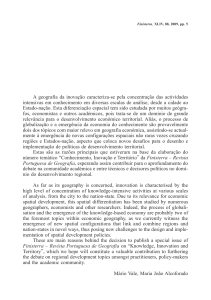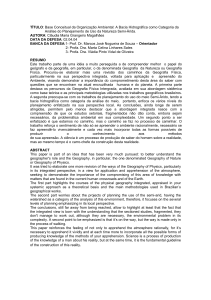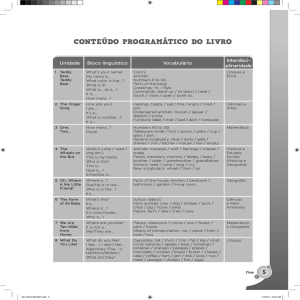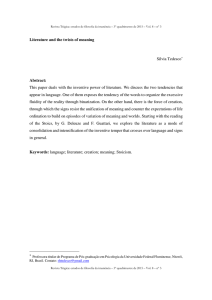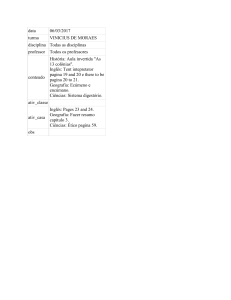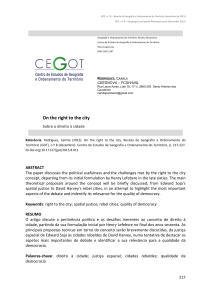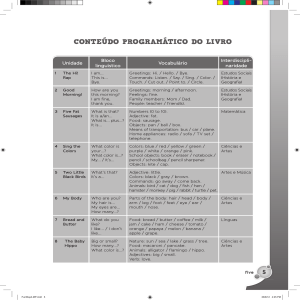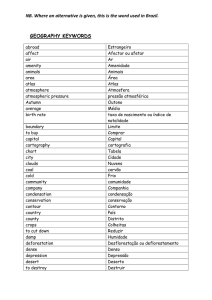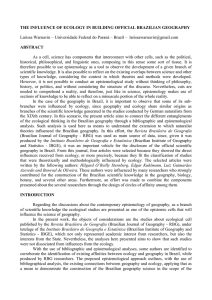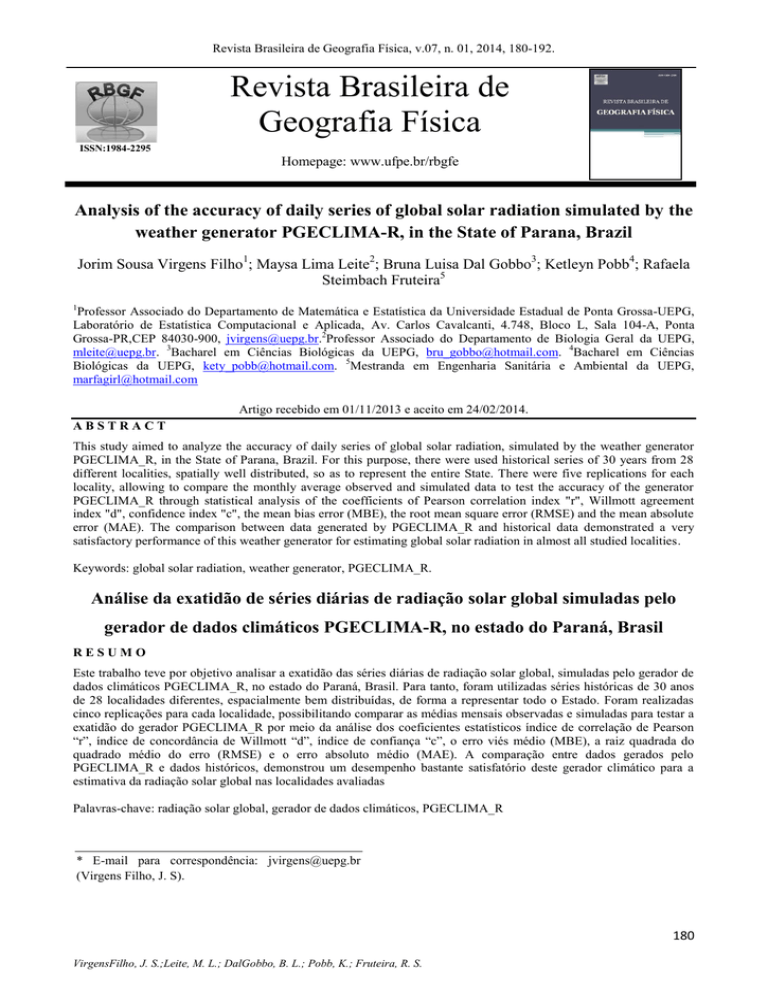
Revista Brasileira de Geografia Física, v.07, n. 01, 2014, 180-192.
Revista Brasileira de
Geografia Física
ISSN:1984-2295
Homepage: www.ufpe.br/rbgfe
Analysis of the accuracy of daily series of global solar radiation simulated by the
weather generator PGECLIMA-R, in the State of Parana, Brazil
Jorim Sousa Virgens Filho1; Maysa Lima Leite2; Bruna Luisa Dal Gobbo3; Ketleyn Pobb4; Rafaela
Steimbach Fruteira5
1
Professor Associado do Departamento de Matemática e Estatística da Universidade Estadual de Ponta Grossa-UEPG,
Laboratório de Estatística Computacional e Aplicada, Av. Carlos Cavalcanti, 4.748, Bloco L, Sala 104-A, Ponta
Grossa-PR,CEP 84030-900, [email protected] Associado do Departamento de Biologia Geral da UEPG,
[email protected]. 3Bacharel em Ciências Biológicas da UEPG, [email protected]. 4Bacharel em Ciências
Biológicas da UEPG, [email protected]. 5Mestranda em Engenharia Sanitária e Ambiental da UEPG,
[email protected]
Artigo recebido em 01/11/2013 e aceito em 24/02/2014.
ABSTRACT
This study aimed to analyze the accuracy of daily series of global solar radiation, simulated by the weather generator
PGECLIMA_R, in the State of Parana, Brazil. For this purpose, there were used historical series of 30 years from 28
different localities, spatially well distributed, so as to represent the entire State. There were five replications for each
locality, allowing to compare the monthly average observed and simulated data to test the accuracy of the generator
PGECLIMA_R through statistical analysis of the coefficients of Pearson correlation index "r", Willmott agreement
index "d", confidence index "c", the mean bias error (MBE), the root mean square error (RMSE) and the mean absolute
error (MAE). The comparison between data generated by PGECLIMA_R and historical data demonstrated a very
satisfactory performance of this weather generator for estimating global solar radiation in almost all studied localities.
Keywords: global solar radiation, weather generator, PGECLIMA_R.
Análise da exatidão de séries diárias de radiação solar global simuladas pelo
gerador de dados climáticos PGECLIMA-R, no estado do Paraná, Brasil
RESUMO
Este trabalho teve por objetivo analisar a exatidão das séries diárias de radiação solar global, simuladas pelo gerador de
dados climáticos PGECLIMA_R, no estado do Paraná, Brasil. Para tanto, foram utilizadas séries históricas de 30 anos
de 28 localidades diferentes, espacialmente bem distribuídas, de forma a representar todo o Estado. Foram realizadas
cinco replicações para cada localidade, possibilitando comparar as médias mensais observadas e simuladas para testar a
exatidão do gerador PGECLIMA_R por meio da análise dos coeficientes estatísticos índice de correlação de Pearson
“r”, índice de concordância de Willmott “d”, índice de confiança “c”, o erro viés médio (MBE), a raiz quadrada do
quadrado médio do erro (RMSE) e o erro absoluto médio (MAE). A comparação entre dados gerados pelo
PGECLIMA_R e dados históricos, demonstrou um desempenho bastante satisfatório deste gerador climático para a
estimativa da radiação solar global nas localidades avaliadas
Palavras-chave: radiação solar global, gerador de dados climáticos, PGECLIMA_R
* E-mail para correspondência: [email protected]
(Virgens Filho, J. S).
180
VirgensFilho, J. S.;Leite, M. L.; DalGobbo, B. L.; Pobb, K.; Fruteira, R. S.
Revista Brasileira de Geografia Física, v.07, n. 01, 2014, 001-013.
It stands currently the PGECLIMA_R
Introduction
are
– Stochastic Generator of Climate Scenarios
computational tools, which are mathematical
(Virgens Filho et al., 2011a; Virgens Filho et
simulation models designed to generate
al., 2011b), which can be considered an
synthetic series of climate data with the same
evolution of SEDAC-R, with the difference
statistical characteristics of the historical
that in addition to simulate weather data, it is
series. These, in turn, have been used in
also capable of generating climate scenarios
various areas of human activity, as they allow
from future statistics disturbance in climate
the analysis of information on local climate,
variables. This model simulates daily weather
and from simulations, makes it possible to
data series of rainfall, air temperature
evaluate the influence of climate on natural or
(minimum and maximum), relative humidity
human-induced processes.
and global solar radiation, and can also fill the
The
weather
generators
Weather generators have also been
remaining
gaps
in
historical
series,
important in the modeling and analysis of
parameterize the existing data and simulate
ecosystems. Kittel et al. (1995) used this
the missing data.
feature to build a bioclimatic database,
Among the climatic variables, the
enabling the analysis of the sensitivity of an
solar radiation can be identified as the main
ecosystem to climate change.
element
related
to
the
meteorological
According to Zanetti (2003) the use of
phenomena, due to the fundamental character
weather generators in the construction of
of his direct intervention of life on Earth.
future climate scenarios, aimed at predicting
According to Valiati (2005), solar radiation is
events that might occur at some time in a
a primary climatological variable, responsible
location of interest, is an alternative of great
for the distribution of fauna and flora on the
interest due to the lack of observed data series
planet, directly influencing the physiological
in the future, allowing thus the use of
activity of living beings and the elements of
simulated data.
weather, so plant and animal production
Today, there are several weather
depend directly on availability of solar
generators developed, and some better known
energy. Pereira et al. (2002), also argue that
may be cited as example: CLIGEN – Climate
solar radiation is the primary source of all
Generator (Nicks et al., 1995), LARS-WG
atmospheric
(Semenov & Barrow, 1997), SEDAC_R -
chemical and biological processes observed in
Stochastic
ecosystems.
Simulator
of
Climatic
Data
and
physical,
It can also be used in various forms,
(Virgens Filho, 2001), and ClimaBR (Zanetti,
2003).
phenomena
such as the capture by the biomass, heating
181
VirgensFilho, J. S.;Leite, M. L.; DalGobbo, B. L.; Pobb, K.; Fruteira, R. S.
Revista Brasileira de Geografia Física, v.07, n. 01, 2014, 001-013.
ventilation and water for domestic and
Material and methods
industrial purposes, photoelectricity for small
The historical series of global solar
potential and sources for thermodynamic
radiation, measured in langley.day-1 (ly),
cycles.
referring to the twenty-eight locations in the
In this context, this study aimed to
State of Parana, Brazil (Figure 1 and Table 1)
analyze the accuracy of daily series of global
were obtained from meteorological stations
solar radiation simulated by the weather
belonging to the Agronomical Institute of
generator PGECLIMA_R in the State of
Parana – IAPAR.
Parana, Brazil.
Source: The author
Figure 1. Selected locations in the State of Parana, Brazil.
182
VirgensFilho, J. S.;Leite, M. L.; DalGobbo, B. L.; Pobb, K.; Fruteira, R. S.
Revista Brasileira de Geografia Física, v.07, n. 01, 2014, 001-013.
Table 1. Geographical coordinates of the meteorological stations.
Localities
Apucarana
Bandeirantes
Bela Vista do Paraíso
Cambará
Cascavel
Cerro Azul
Cianorte
Clevelândia
Fernandes Pinheiro
Francisco Beltrão
Guarapuava
Guaraqueçaba
Ibiporã
Joaquim Távora
Laranjeiras do Sul
Londrina
Morretes
Nova Cantú
Palmas
Palotina
Paranavaí
Pato Branco
Pinhais
Planalto
Ponta Grossa
Quedas do Iguaçu
Telêmaco Borba
Umuarama
Latitude (S)
23° 30' S
23° 06' S
22° 57' S
23° 00' S
24° 26' S
24° 49' S
23° 40' S
26° 25' S
25° 27' S
26° 05' S
25° 21' S
25° 16' S
23° 16' S
23°30' S
25° 25' S
23° 22' S
25° 30' S
24° 40' S
26° 29' S
24° 18' S
23° 05' S
26° 07' S
25° 25' S
25° 42' S
25° 13' S
25° 31' S
24° 20' S
24° 44' S
Longitude (W)
51° 32' W
50° 21' W
51° 12' W
50° 2' W
53° 26' W
49° 15' W
52° 35' W
52° 21' W
50° 35' W
53° 4' W
51° 30' W
48° 32' W
51° 1' W
49° 57' W
52° 25' W
51° 10' W
48° 49' W
52° 34' W
51° 59' W
53° 55' W
52° 26' W
52° 41' W
49° 8' W
53° 47' W
50° 1' W
53° 1' W
50° 37' W
53° 17' W
Thus, the accuracy of PGECLIMA_R
Altitude (m)
746m
440m
600m
450m
760m
360m
530m
930m
893m
650m
1058m
40m
484m
512m
880m
585m
59m
540m
1100m
310m
480m
700m
930m
400m
880m
513m
768m
480m
In more detail, to calculate the
comparison
confidence index “c”, it was used the Pearson
between different coefficients, by starting
correlation coefficient “r”, precision indicator,
confidence index “c” (equation 1), proposed
which measures the degree of dispersion
by Camargo & Sentelhas (1997), whose
among the observed and simulated and the
criteria are shown in Table 2.
coefficient of agreement “d” proposed by
was
obtained
by
statistical
Willmott (1981), regarding the accuracy. The
latter indicates the distance between estimated
and observed data, ranging from the 0 (no
183
VirgensFilho, J. S.;Leite, M. L.; DalGobbo, B. L.; Pobb, K.; Fruteira, R. S.
Revista Brasileira de Geografia Física, v.07, n. 01, 2014, 001-013.
correlation) to 1 (perfect agreement), and is
where Pi represents the monthly averages of
described by the following equation:
the series simulated by weather generators, Oi
the monthly averages of the observed
d
[
∑
∑ |
i
|
i
historical series and O represents the mean
i
|
i
|
]
values of historical monthly averages.
Table 2. Criteria for interpretation of performance PGECLIMA_R, by the index "c" (Camargo &
Sentelhas, 1997).
Value of “c”
> 0,85
0,76 a 0,85
0,66 a 0,75
0,61 a 0,65
0,51 a 0,60
0,41 a 0,50
< 0,40
Performance
Excellent
Very good
Good
Median
Tolerable
Poor
Very Poor
It was used MBE (Mean Bias Error),
model in the short term, and the lower its
which represents the deviation of the mean.
value, the lower the data dispersion. Its
This is an indicator that provides information
disadvantage is that just a few outliers are
on the performance of a long-term model.
enough to a significant increase in its results
Can be represented by negative values
(Stone, 1993).
(MBE<0) or positive
indicating
an
values
(MBE>0),
underestimation
∑
[
or
]
overestimation, respectively, represented by
equation 3:
It was also used mean absolute error,
∑
MAE
(Mean
Absolute
Error),
which
according to Willmott (2005) (equation 5), is
To analyze the dispersion between the
observed and simulated values due to non-
a more natural measure of average error, and
(unlike RMSE) is unequivocal.
systematic errors, were used RMSE (Root
∑
Mean Square Error) (equation 4), which is
|
|
related to the real value of the error produced
by
the
model.
This
index
provides
For the application of equations 3, 4
information about the performance of the
and 5, it is considered that Pi represents the
184
VirgensFilho, J. S.;Leite, M. L.; DalGobbo, B. L.; Pobb, K.; Fruteira, R. S.
Revista Brasileira de Geografia Física, v.07, n. 01, 2014, 001-013.
monthly averages of the series simulated by
observed averages with the averages of the
weather generator, Oi the monthly averages of
simulated data through the analysis of graphs.
the observed historical series, and N is the
number of observed values, of historical
Results and discussion
In Table 3 are represented the values
series.
To complement the study it was also
of statistical indexes r, d, c, MBE, RMSE and
carried out a visual comparison of the
MAE for the global solar radiation on dry
days in the twenty-eight evaluated localities.
Table 3. Statistical index for evaluating the performance of PGECLIMA_R in the simulation of
global solar radiation on dry days.
Localities
Apucarana
Bandeirantes
Bela Vista do Paraíso
Cambará
Cascavel
Cerro Azul
Cianorte
Clevelândia
Fernandes Pinheiro
Francisco Beltrão
Guarapuava
Guaraqueçaba
Ibiporã
Joaquim Távora
Laranjeiras do Sul
Londrina
Morretes
Nova Cantú
Palmas
Palotina
Paranavaí
Pato Branco
Pinhais
Planalto
Ponta Grossa
Quedas do Iguaçu
Telêmaco Borba
Umuarama
r
0.9995
0.9995
0.9998
0.9905
0.9995
0.9997
0.9997
0.9996
0.9994
0.9995
0.9982
0.9973
0.9992
0.9992
0.9995
0.9992
0.9969
0.9993
0.9969
0.9656
0.9970
0.9988
0.9924
0.9991
0.9998
0.9958
0.9995
0.9999
d
0.9993
0.9986
0.9996
0.9879
0.9997
0.9994
0.9998
0.9994
0.9987
0.9994
0.9967
0.9942
0.9988
0.9992
0.9994
0.9986
0.9964
0.8232
0.9879
0.9567
0.8045
0.9978
0.8623
0.8592
0.9998
0.9968
0.9993
0.9998
c
0.9987
0.9981
0.9994
0.9785
0.9992
0.9991
0.9995
0.9990
0.9981
0.9989
0.9949
0.9915
0.9980
0.9984
0.9990
0.9978
0.9934
0.8226
0.9848
0.9238
0.8021
0.9966
0.8557
0.8584
0.9996
0.9926
0.9988
0.9997
MBE (ly)
3.0870
4.3850
2.7317
11.8991
1.2362
3.4593
0.2046
3.3006
5.3716
3.2397
7.2004
9.8601
4.4660
3.7322
2.6288
4.2449
6.1479
-60.5208
16.9914
24.3327
-69.0428
7.6332
-54.7765
-68.1853
1.5434
6.0811
2.5954
1.9310
RMSE (ly)
4.5165
6.2100
3.4395
16.6745
2.5438
4.2591
2.0828
4.3384
6.8060
4.6024
9.1845
11.2401
6.1388
5.2840
3.7924
6.3963
8.5662
61.5374
18.5740
32.7292
70.2511
8.8640
57.0923
70.4884
2.1587
10.9064
3.9030
2.3923
MAE (ly)
3.3386
4.9850
2.8054
11.8991
2.1413
3.6394
1.5654
3.4094
5.4823
3.5144
7.2004
9.8601
4.4660
4.3842
2.9275
4.5723
6.6432
60.5208
16.9914
24.3327
69.0428
7.6332
54.7765
68.1853
1.6298
6.3812
2.9222
2.2937
185
VirgensFilho, J. S.;Leite, M. L.; DalGobbo, B. L.; Pobb, K.; Fruteira, R. S.
Revista Brasileira de Geografia Física, v.07, n. 01, 2014, 001-013.
The occurrence of values greater than
and index "c", by the fact that in cities where
0.99 for the index "r" in almost all localities,
there was a less satisfactory performance in
allowed
correlation
one of these indexes, the other in turn,
between predicted and observed data, which
showed very similar results, also lower than
can be considered an excellent performance
the others.
establishing
a
high
for the index. Baena (2004), testing the model
As proposed by Stone (1993), which
ClimaBR to generate synthetic series of
states that the smaller the values of MBE and
precipitation in Brazil and analyzing the solar
RMSE, the better the agreement between the
radiation, also used the correlation coefficient,
observed and simulated data, and also
concordance rates and confidence and found
considering the fact that these indexes are
values above 0.98, considering this a great
measured dimensional, i.e. depend on the unit
performance.
so that the data presented in the variable of
In the analysis of the concordance
interest, to determine if the index value
coefficient "d" regarding the accuracy, there
indicates compliance or non of simulated and
were few observed values, ranging from 0.80
observed values (Willmott, 2006), it is
to 0.86, linked to the cities of Nova Cantu,
possible then, when were performed the
Paranavai, Pinhais and Planalto, indicating a
analysis of the MBE index, to observe the
greater distance between the simulated and
occurrence of small deviations in comparison
observed values, while in most locations the
with the variable values (ly) in question, both
values were above 0.99, corresponding to a
for overestimation as to underestimation,
minimum distance between the simulated and
indicating a greater agreement of the observed
observed data.
and simulated values, i.e. a lower incidence of
When interpreted the results of the
errors or deviations.
concordance coefficient, according to the
The only places where the values were
performance criteria proposed by Camargo &
more distinct, representing larger deviations
Sentelhas (1997), were observed that the
between simulated and observed data, were
values obtained for the index "c", confidence,
the cities of Nova Cantu, Paranavai, Pinhais
were above 0.86 for most cities, which can be
and Planalto, which, in turn, presented in the
considered "Excellent", except Nova Cantu
same way, less performance considered
and Paranavai, which had values between
satisfactory when analyzed the indexes "c"
0.80 and 0.82, considered "Very good". It can
and "d".
be seen the relationship between the index "d"
186
VirgensFilho, J. S.;Leite, M. L.; DalGobbo, B. L.; Pobb, K.; Fruteira, R. S.
Revista Brasileira de Geografia Física, v.07, n. 01, 2014, 001-013.
The same occurs with indexes RMSE
Pinhais and Planalto, the values of the index
and MAE, which values were small for most
"d" indicated a greater deviation between
locations, citing as an example, Cianorte,
predicted and observed data, these being,
which showed RMSE of 2.08 ly, and a MAE
values ranging from 0.86 to 0.89.
of 1.57 ly, evidencing then small deviations
between observed and simulated data.
The values obtained for the index "c"
occurred all above 0.86, thus, according to the
Figure 2 shows the annual trend of the
classification
series of global solar radiation on dry days to
Sentelhas
the twenty-eight sites studied, which allows to
"Excellent".
check-out
close
Camargo
being
&
considered
Similarly to what occurred during dry
observed and simulated data in most places,
periods, the index for MBE in wet periods,
even
showed high values underestimated, which
cases
similarity
(1997),
by
between
in
the
proposed
where
there
was
an
underestimation for the towns of Nova Cantu,
range
Paranavaí, Pinhais and Planalto, and this was
representing a greater spacing between the
quantified by the indexes MBE, RMSE and
observed and simulated data in the localities,
MAE.
showing underestimates in the cities of Nova
In Table 4 are represented the values
from
-42.21
ly
to
-50,39
ly,
Cantu, Paranavai, Pinhais and Planalto.
of statistical indexes r, d, c, MBE, RMSE and
It indicates a greater error according to
MAE for the global solar radiation on wet
Stone (1993), which states that the lower the
days in the twenty-eight locations.
index value MBE, the better the model. But in
It was observed that the simulated
values
have
high
correlation
with
most localities, the index values for MBE
the
were very satisfactory, for example, in the
observed, because the index "r" in all regions
city of Cerro Azul, which had a value of 0.64
showed values greater than 0.98, which can
ly for MBE, indicating strong agreement
be considered excellent.
between the observed and simulated data,
When analyzed the concordance index
representing a very small error.
"d" values were above 0.97, demonstrating an
excellent
result,
which
showed
to
be
Likewise,
indexes
showed
the
the
MAE
most
and
RMSE
significant
consistent with the data obtained by Pereira et
deviations also in these four localities,
al. (2002), in monitoring the full potential of
representing a larger distance between the
global solar radiation in the city of Ponta
observed and simulated data, but in other
Grossa, where it was obtained high accuracy
places the values obtained were much lower.
"d" with a value of 0.98. As noted previously
For example, the city of Fernandes
for dry days in Nova Cantu, Paranavai,
Pinheiro, which showed an RMSE of 3.61 ly,
187
VirgensFilho, J. S.;Leite, M. L.; DalGobbo, B. L.; Pobb, K.; Fruteira, R. S.
Revista Brasileira de Geografia Física, v.07, n. 01, 2014, 001-013.
and a MAE of 2.97 ly, indicates smaller
performance
of
PGECLIMA_R
in
the
deviations between series of synthetic data
generation of series of global solar radiation
and historical data, representing in turn,
on wet days in these localities.
reduced errors, and satisfactory results on the
Source: The author
Figure 2. Annual trend of the series of global solar radiation on dry days to evaluate the
performance of PGECLIMA_R.
188
VirgensFilho, J. S.;Leite, M. L.; DalGobbo, B. L.; Pobb, K.; Fruteira, R. S.
Revista Brasileira de Geografia Física, v.07, n. 01, 2014, 001-013.
Table 4. Statistical indexes for evaluating the performance of PGECLIMA_R in the simulation of
global solar radiation on wet days.
Localities
Apucarana
Bandeirantes
Bela Vista do Paraíso
Cambará
Cascavel
Cerro Azul
Cianorte
Clevelândia
Fernandes Pinheiro
Francisco Beltrão
Guarapuava
Guaraqueçaba
Ibiporã
Joaquim Távora
Laranjeiras do Sul
Londrina
Morretes
Nova Cantú
Palmas
Palotina
Paranavaí
Pato Branco
Pinhais
Planalto
Ponta Grossa
Quedas do Iguaçu
Telêmaco Borba
Umuarama
r
0.9993
0.9939
0.9983
0.9889
0.9802
0.9972
0.9837
0.9854
0.9991
0.9990
0.9859
0.9988
0.9977
0.9978
0.9931
0.9890
0.9813
0.9976
0.9991
0.9660
0.9914
0.9987
0.9881
0.9838
0.9937
0.9950
0.9925
0.9971
d
0.9986
0.9953
0.9975
0.9864
0.9788
0.9983
0.9890
0.9878
0.9995
0.9989
0.9834
0.9986
0.9974
0.9970
0.9943
0.9938
0.9776
0.8564
0.9993
0.9679
0.8704
0.9988
0.8696
0.8980
0.9945
0.9945
0.9909
0.9979
c
0.9979
0.9893
0.9958
0.9755
0.9594
0.9955
0.9729
0.9734
0.9986
0.9979
0.9695
0.9974
0.9951
0.9949
0.9874
0.9829
0.9593
0.8543
0.9984
0.9349
0.8630
0.9976
0.8593
0.8834
0.9882
0.9895
0.9835
0.9950
MBE (ly)
-4.6793
4.0708
-5.8948
10.6936
11.6631
-0.6404
5.7624
9.4445
-0.0192
-3.5193
11.0073
2.7600
-3.8902
-6.6439
5.7093
0.6007
11.6285
-50.0880
-2.0059
17.9581
-49.4991
-3.5905
-42.2098
-50.3901
5.5332
8.9461
5.0837
-4.4972
RMSE (ly)
5.5093
10.2248
8.1644
16.0648
18.4846
5.4210
15.4240
18.4525
3.6188
5.8053
16.8282
4.0297
7.8435
8.8725
12.2789
11.4513
17.3657
52.0690
3.9981
26.3017
53.2758
5.8356
46.0275
55.3173
10.6711
12.6159
11.0127
8.3355
MAE (ly)
4.9917
7.9739
6.9937
11.2659
12.8969
4.1843
9.8368
14.5962
2.9726
4.8895
14.3139
3.0963
6.5197
8.0369
8.7454
8.2942
12.0910
50.0880
2.6474
20.2941
49.4991
4.8343
42.2098
50.3901
7.6111
9.6038
7.4930
5.9531
The Figure 3 represents the behavior
Importantly, on wet days, the averages
of the series of annual global solar radiation
of simulated global solar radiation, in the
on wet days to the twenty-eight localities
evaluated localities, sometimes overestimated
studied, from which one can see the close
and sometimes underestimated the historical
similarity between observed and simulated
monthly averages. On the other hand, this was
global solar radiation data in most cities, thus
not observed in dry days, since only four
leading to a very good result.
localities (Nova Cantu, Paranavai, Pinhais and
Planalto), presented a clear underestimation,
189
VirgensFilho, J. S.;Leite, M. L.; DalGobbo, B. L.; Pobb, K.; Fruteira, R. S.
Revista Brasileira de Geografia Física, v.07, n. 01, 2014, 001-013.
while the other locations showed only small
deviations around the mean.
Source: The author
Figure 3. Annual trend of the series of global solar radiation on wet days to evaluate the
performance of PGECLIMA_R.
Conclusions
accuracy of the daily series of global solar
Considering the results obtained from
radiation simulated by the weather generator
the use of the statistical coefficients r, d, c,
PGECLIMA_R, in the State of Parana, Brazil,
MBE, MAE and RMSE to evaluate the
it is concluded that it had a very good
190
VirgensFilho, J. S.;Leite, M. L.; DalGobbo, B. L.; Pobb, K.; Fruteira, R. S.
Revista Brasileira de Geografia Física, v.07, n. 01, 2014, 001-013.
performance in simulating the daily global
Nicks, A.D.; Lane, L .J.; Gander, G.A. 1995.
solar radiation, in almost all of the twenty-
Weather Generator. In: USDA-ARS National
eight localities, getting very satisfactory
Soil Erosion Research Laboratory. Water
values for both conditions, wet and dry days,
erosion prediction project. West Lafayette:
for all the analyzed coefficients.
USDA. Cap.2, p. 2.1-2.22.
Acknowledgments
Pereira, A.B.; Vrisman, A.L.; Galvani, E.
Araucaria
2002. Estimativa da radiação solar global
Foundation for financial support and IAPAR
diária em função do potencial de energia solar
for granting the weather data.
na superfície do solo. Scientia Agricola, v. 59,
CNPq,
FINEP
and
n. 2, p.211-216.
References
Baena, L.G.N. 2004. Modelo para geração de
séries sintéticas de dados climáticos, 85 f.
Tese (Doutorado em Engenharia Agrícola, na
área de concentração de Recursos Hídricos e
Ambientais)
-
Universidade
Federal
de
Viçosa, Viçosa.
Camargo,
A.P.;
stochastic
Sentelhas,
P.C.
1997.
métodos de estimativa da evapotranspiração
potencial no Estado de São Paulo. Revista
Brasileira de Agrometeorologia, Santa Maria,
v. 5, n. 1, p. 89-97.
Kittel, T.G.F.; Rosenbloom, N.A.; Painter,
T.H.; Schimel, D.S. 1995. The VEMAP
integrated database for modeling United
States ecosystem/vegetation sensitivity to
climate change. Journal of Biogeography, v.
weather
generator
in
the
development of climate change scenarios.
Climatic Change, Netherlands, v. 35, p. 397415.
Stone,
Avaliação do desempenho de diferentes
2, p.857-862.
Semenov, M.A.; Barrow, E.M. 1997. Use of a
R.J.
1993.
Improved
statistical
procedure for the evaluation of solar radiation
estimation models. Solar Energy, v. 51, n. 4,
p. 289-291.
Valiati, M.I. 2005. Calibração e validação do
modelo RadEst 3.0 para estimativa da
irradiação solar global em função de medidas
de temperatura do ar máxima e mínima, 63 f.
Tese (Doutorado em Agronomia, na área de
concentração em Irrigação e Drenagem) –
Universidade Estadual Paulista, Botucatu.
Virgens Filho, J.S.; Félix, R.P.; Leite, M.L.;
Tsukahara,
Gerador
R.Y.
2011ª.
estocástico
para
PGECLIMA_R:
simulação
de
191
VirgensFilho, J. S.;Leite, M. L.; DalGobbo, B. L.; Pobb, K.; Fruteira, R. S.
Revista Brasileira de Geografia Física, v.07, n. 01, 2014, 001-013.
cenários
climáticos
brasileiros.
I
–
Desenvolvimento do gerenciador do banco de
Willmott, C.J. 1981. On the validation of
dados
models. Physical Geography, Silver Spring,
climáticos.
Brasileiro
de
In:
XVII
Congresso
Agrometeorologia,
2011,
v.2, n.2, p.184-194.
Guarapari, Anais... Guaraparí, Sociedade
Brasileira de Agrometeorologia, p.1-5.
Willmott,
C.J.;
Matsuura,
K.
2005.
Advantages of the mean absolute error
Virgens Filho, J.S.; Oliveira, P.M.; Leite,
(MAE) over the root mean square error
M.L.;
(RMSE)
Tsukahara,
R.Y.
2011b.
PGECLIMA_R: Gerador estocástico para
in
assessing
average
model
performance. Climate Research,v.30, p.79-82.
simulação de cenários climáticos brasileiros.
II – Automação da análise estatística e
Willmott, C.J.; Matsuura K. 2006. On the use
validação dos dados simulados. In: XVII
of dimensioned measures of error to evaluate
Congresso Brasileiro de Agrometeorologia,
the performance of spatial interpolators.
2011,
International
Guarapari,
Anais...
Guaraparí,
Sociedade Brasileira de Agrometeorologia,
Journal
of
Geographical
Information Science, v.20, n.1, p. 89-102.
p.1-5.
Zanetti, S.S. 2003. Modelo computacional
Virgens
Filho,
J.S.
2001.
Ferramenta
para
geração
de
séries
sintéticas
de
computacional para simulação de séries
precipitação e do seu perfil instantâneo, 71f.
climáticas diárias, baseada na parametrização
Dissertação
dinâmica das distribuições de probabilidade,
Agrícola). - Universidade Federal de Viçosa,
92f. Tese (Doutorado em Agronomia/Energia
Viçosa.
(Mestrado
em
Engenharia
na Agricultura) - Faculdade de Ciências
Agronômicas, Universidade Estadual Paulista,
Botucatu.
192
VirgensFilho, J. S.;Leite, M. L.; DalGobbo, B. L.; Pobb, K.; Fruteira, R. S.

